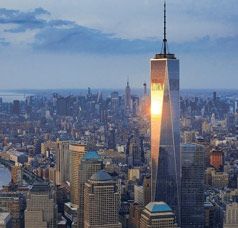Two Lehigh University alumni are adding another chapter to the long association between Lehigh and New York City’s World Trade Center.
Mark Osler ’98 and Bob Gallup ’86 have helped design a flood-mitigation plan to protect the new WTC from a massive storm like Hurricane Sandy, which caused a 9-foot floodwater surge and inflicted more than $40 billion in damage on New York in 2012.
Osler is assistant vice president and Gallup is director of civil engineering for Michael Baker International, a global engineering firm which won a contract from the Port Authority of New York and New Jersey to develop the WTC flood-protection plan. Both alumni received B.S. degrees in civil engineering.
Osler, who works in Baker’s office in Alexandria, Va., is assessing sea level rise, hurricane storm surge, coastal flood risk and hydraulic loading. Gallup, who works in the White Plains, N.Y., office, oversees the civil and structural aspects of the project while serving as project and client manager.
The new World Trade Center, which is partially completed, occupies 16 acres in Lower Manhattan and houses the 9/11 Museum and Memorial Plaza, five office towers, an underground Transportation Hub serving New York and New Jersey, and half a million square feet of shops and restaurants.
The site’s centerpiece, One World Trade Center, replaces the Twin Towers of the original World Trade Center, which were destroyed by terrorists on Sept. 11, 2001. At 1,776 feet, the new skyscraper, which opened last November, is the tallest building in the Western Hemisphere.
The main feature of the Baker mitigation design, says Osler, is an aluminum flood wall that can be fitted onto the security bollards—steel posts filled with concrete—positioned along the WTC site’s perimeter roadways.
“This is a scalable solution,” says Osler. “We can make the wall 5 feet high if the [water] surge is expected to be 3 feet, or 8 feet high for a 6-foot surge. The use of segmented panels or flood logs for a flood wall system is well-known in the industry; ours is the first design that utilizes bollards as an independent support from the building.”
The chance to work with Osler, says Gallup, has been another benefit of the flood-mitigation project. The two alumni were not acquainted before the Port Authority awarded the contract to Baker.
“Mark is one of the professionals within the company whose opinion I hold in high regard,” says Gallup. “His Lehigh pedigree came shining through on this project.”
Osler, a native of Hingham, Massachusetts, spent much of his childhood on the beaches of Cape Cod and nearby islands. At Lehigh, he took all of his engineering electives in coastal engineering, studying with Robert Sorensen, professor emeritus of civil engineering and author of half a dozen books on hydraulics and wave mechanics.
“Dr. Sorensen gave me a lot of journal articles to read and crafted a 3-credit course for me so I could work with graduate students on a coastal engineering research project,” says Osler. “I have remained in his debt ever since.”
Read the full story at the Lehigh University News Center.
-Kurt Pfitzer is a writer with Lehigh University Media Relations.

